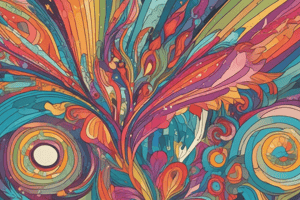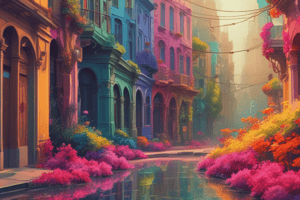Podcast
Questions and Answers
Which type of colour is associated with an impression of calm?
Which type of colour is associated with an impression of calm?
- Cool colours (correct)
- Neutral colours
- Warm colours
- Muted colours
Which colour has a calming effect?
Which colour has a calming effect?
- Blue (correct)
- Yellow
- Green
- Red
In the RYB colour model, which are the secondary colours?
In the RYB colour model, which are the secondary colours?
- Green, orange, purple (correct)
- Brown, grey, black
- Blue, green, purple
- Red, yellow, blue
What is the basic tool for combining colours?
What is the basic tool for combining colours?
Which scientist designed the first circular colour diagram in 1666?
Which scientist designed the first circular colour diagram in 1666?
What do warm colours tend to do in space?
What do warm colours tend to do in space?
Which combination of colours consists of two or more colours with a fixed relation in the colour wheel?
Which combination of colours consists of two or more colours with a fixed relation in the colour wheel?
What is designed to dynamically create a colour wheel to match your base colour?
What is designed to dynamically create a colour wheel to match your base colour?
In the RYB colour model, which are the primary colours?
In the RYB colour model, which are the primary colours?
What is the primary goal of colour theory in art and design?
What is the primary goal of colour theory in art and design?
Based on Isaac Newton's colour wheel, what are the primary colours?
Based on Isaac Newton's colour wheel, what are the primary colours?
What are the secondary colours created by mixing two primary colours?
What are the secondary colours created by mixing two primary colours?
Which colour scheme is based on three colours located next to each other on the colour wheel?
Which colour scheme is based on three colours located next to each other on the colour wheel?
What does distinguishing between warm, cool, and neutral colours in design apparently have the power to do?
What does distinguishing between warm, cool, and neutral colours in design apparently have the power to do?
What distinguishes the split-complementary colour scheme from the analogous and complementary schemes?
What distinguishes the split-complementary colour scheme from the analogous and complementary schemes?
Flashcards are hidden until you start studying




